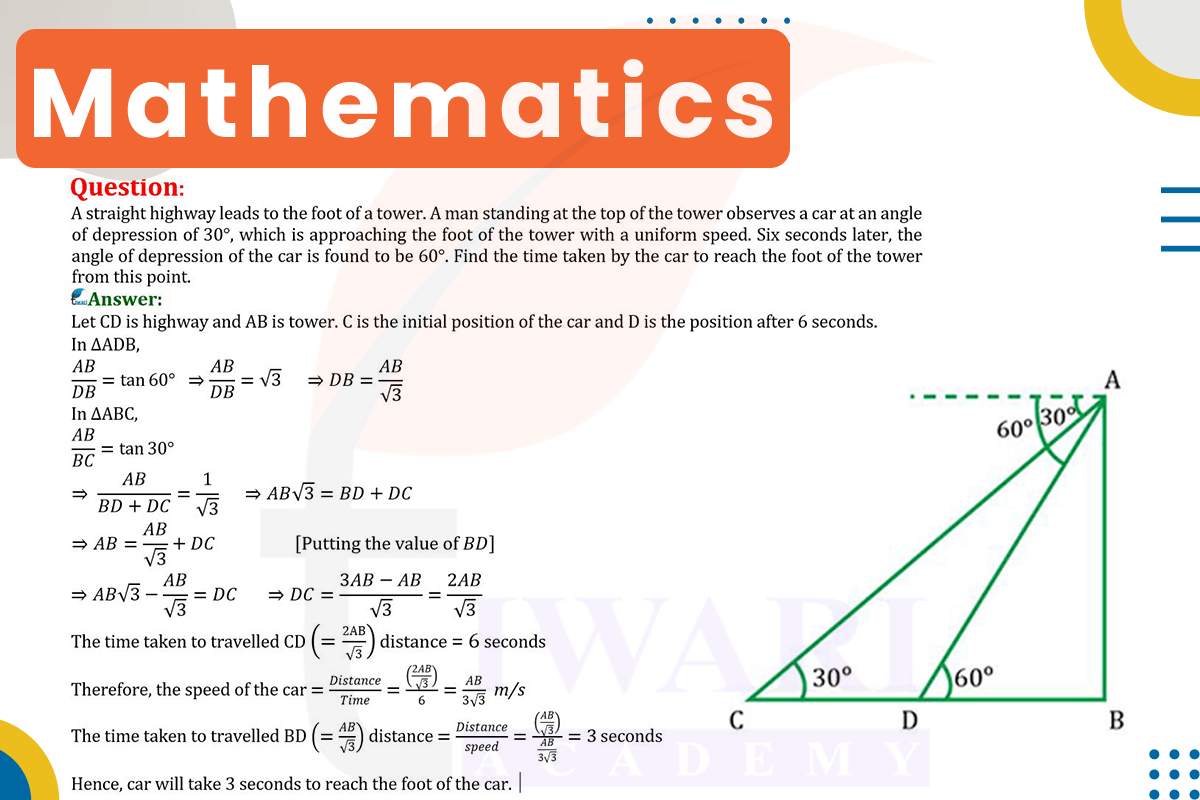To find the time taken by the car to reach the foot of the tower, we use trigonometry. Let’s denote the height of the tower as h, the initial distance of the car from the tower as d1, and the distance after 6 seconds as d2.
Initial Position (30° Angle of Depression): Using tan(30°) = 1/√3, the equation is 1/√3 = h/d1.
Position After 6 Seconds (60° Angle of Depression): Using tan(60°) = √3, the equation is √3 = h/d2.
Since d1 = h√3 and d2 = h/√3, the distance covered in 6 seconds is h√3 − h/√3. The speed of the car is this distance divided by 6 seconds. To find the time to reach the tower, use the speed and the distance h/√3. The time taken is (h/√3)/speed, which simplifies to 2 seconds. Therefore, it takes the car 2 seconds to reach the foot of the tower from the latter position.

Let’s discuss in detail
Trigonometric Analysis in Motion Estimation
Trigonometry, a significant branch of mathematics, is often employed in estimating motion and distances, especially in scenarios where direct measurement is not feasible. The problem at hand involves a car approaching a tower, with its angles of depression observed from the tower’s top changing over time. By applying trigonometric principles to these observations, we can estimate the time it will take for the car to reach the tower. This scenario is a practical demonstration of how trigonometry can be applied to solve real-world problems in fields like physics, engineering, and navigation.
Understanding the Problem: Car Approaching a Tower
The problem presents a car moving towards a tower along a straight highway. A man standing at the top of the tower observes the car at an angle of depression of 30°. After six seconds, the angle of depression changes to 60°. The objective is to determine the time it will take for the car to reach the foot of the tower from its position at the 60° angle of depression. This setup forms two right-angled triangles at different instances, one for each angle of depression.
The Role of Tangent in Angle of Depression
In trigonometry, the tangent of an angle in a right-angled triangle is the ratio of the length of the opposite side (height of the tower) to the length of the adjacent side (horizontal distance from the tower). The angles of depression from the tower are equivalent to the angles of elevation from the car to the tower. By applying the tangent function to these angles, we can calculate the car’s distances from the tower at both instances.
Calculating the Initial and Final Distances
For the initial position with a 30° angle of depression, we use the formula tan(30°) = 1/√3. The equation is 1/√3 = h/d1, where d1 is the initial distance. Similarly, for the position after 6 seconds with a 60° angle of depression, the equation is tan(60°) = √3 = h/d2, where d2 is the distance after 6 seconds.
Estimating the Car’s Speed and Time to Reach the Tower
The distance covered by the car in 6 seconds is the difference between d1 and d2, which is h√3 − h/√3. The car’s speed is this distance divided by 6 seconds. To find the time for the car to reach the tower from its position at the 60° angle of depression, we use the speed and the distance h/√3 (the final distance to the tower).
Trigonometry in Determining Time and Distance
The time taken by the car to reach the foot of the tower from the latter position is calculated to be 2 seconds. This example illustrates the practical application of trigonometry in motion estimation and distance calculation, demonstrating its importance in various real-life scenarios. Trigonometry provides a reliable mathematical approach to solving problems where direct measurement of distance and time is challenging, ensuring accuracy and efficiency in planning and analysis.
Discuss this question in detail or visit to Class 10 Maths Chapter 9 for all questions.
Questions of 10th Maths Exercise 9.1 in Detail

